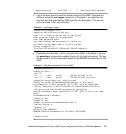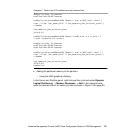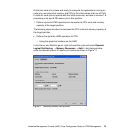
22 Hardware Management Console (HMC) Case Configuration Study for LPAR Management
– Using the command line interface.
Example 7 shows how to deallocate via the command line 6 GB of memory from
node julia.
Example 7 Deallocating the memory using the command line interface (CLI)
root@julia/>lsattr -El mem0
goodsize 7168 Amount of usable physical memory in Mbytes False
size 7168 Total amount of physical memory in Mbytes False
root@julia/>ssh hscroot@hmctot184 lshwres -r mem -m p550_itso1 --level\ \
>lpar --filter "lpar_names=julia" -F lpar_name:curr_mem --header
lpar_name:curr_mem
julia:7168
root@julia/>ssh hscroot@hmctot184 chhwres -m p550_itso1 -o r -p julia \ \
> -r mem -q 6144 -w 15
root@julia/>ssh hscroot@hmctot184 lshwres -r mem -m p550_itso1 --level\ \
>lpar --filter "lpar_names=julia" -F lpar_name:curr_mem --header
lpar_name:curr_mem
julia:1024
root@julia/>lsattr -El mem0
goodsize 1024 Amount of usable physical memory in Mbytes False
size 1024 Total amount of physical memory in Mbytes False
Deallocate the processing units from the partition.
– Using the graphical interface.
In the Server and Partition panel on HMC, right-click partition julia and select
Dynamic Logical Partitioning → Processor Resources → Remove. In the
dialog window, enter the desired values for processing units and virtual
processors as shown in Figure 12 on page 23.
Note: When allocating memory to a partition or moving it between partitions,
you can increase the time-out limit of the operation to prevent a failure
response before the operation completes. Use the Advance tab of the
dynamic LPAR memory menu (see Figure 10 on page 20) to increase the
time-out limit.


















